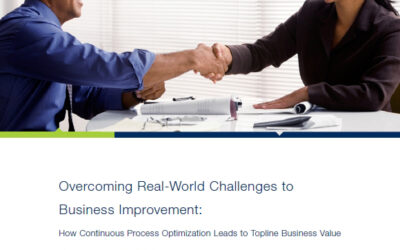Within the world of SOA, services are the building blocks, and at the lowest level of the stack. SOA is an architectural style supporting loosely coupled services that enable the construction of many systems that are technology-agnostic. Services become the base of an SOA, and while some are abstract existing “legacy services,” others are new and built for specific purposes.
Articles by: BPMInstitute.org
BPM/SOA Market Consolidates
![]()
This article originally appeared in the members-only quarterly BPM Strategies Magazine. Join today to receive your own copy.
The convergence of the BPM and SOA markets continues to make news this year and the pace of consolidation has increased in recent months.
BPMS Watch: BPMN Training Revisited
When I launched my course “Process Modeling with BPMN”, I discussed in this column why so many people beginning to “do” BPM were looking for training in modeling, and why that was especially needed for BPMN. Now, having delivered the training for five months, I have a better appreciation of BPMN’s strengths and limitations, a better understanding of what students really want, and what they really need to know about BPMN modeling.
Modeling the True Business Architecture
It has been said that one picture is worth a thousand words, but the veracity of this ancient maxim is radically understated when it comes to modeling the business architecture. Indeed, a well-modeled business architecture is worth its weight in gold, not to mention market share.
SOA Watch: Is Your Enterprise Architecture Healthy?
Working directly on SOA projects, as an independent, I’m exposed to many more organizations than when I was building technology. As such, I see some common patterns or issues emerging.
The largest and most disturbing issue is the fact that there seems to be a huge chasm between the traditional enterprise architecture crowd and those looking at the value of SOA. Indeed, enterprise architecture, as a notion, has morphed from an approach for the betterment of corporate IT to a management practice, at least for some.
Take Your Visio® based Business Process Analysis Project to the Next Level
Are you engaged in or investigating an enterprise wide business process analysis initiative? Need to convince your Visio process modelers to migrate to a more structured environment?
The success of your business process analysis and enterprise architecture depends on the quality of your models. But if your users are modeling without structure and controls, then their models are probably unrelated, non-standard and disparate. Many organizations use Microsoft Visio®, a convenient solution for part-time business modelers.
Process Optimization for the Real World
Many Business Process Management (BPM) vendors talk about how their software allows you to optimize processes with just the click of a button. It’s a nice dream to believe in this “Nirvana” extending to processes outside your immediate scope of control, but the reality is that most people find that their corporate cultures do not empower just one person alone to change thresholds, adjust approval levels, or make wholesale changes to longstanding business processes. In most cases, process involves collaboration and involves other groups and decision-makers.
Goals and Definition
This article is about getting started on a development project. In a way, it is about problem finding. In particular, it is about deciding what is of concern and what is not, and what aspects of policy are important in setting a course toward a plan.
But before I get into that, I have to get something off my chest. It is becoming a real peeve, but it is highly relevant to this article and so worth talking about up front.
BPMS Watch: Understanding and Evaluating BPM Suites
BPM provides more than just a new way of measuring and understanding your business. It also delivers a new technology platform that is critical to realizing the innovation, efficiency, compliance, and agility that BPM promises. That platform, called a BPM Suite (BPMS), supports the complete process implementation lifecycle, from modeling to implementation design, execution, and business activity monitoring, with feedback to modeling for continuous performance improvement.
BPMS offerings have matured greatly in the past year or two. Today most provide a unified design
The Future of Services Engineering
The services sector of business is different than the industrial manufacturing models that have been the primary references for the last century or so. Treating services businesses as if they were just a version of a manufacturer - just substituting the word “service”...





















